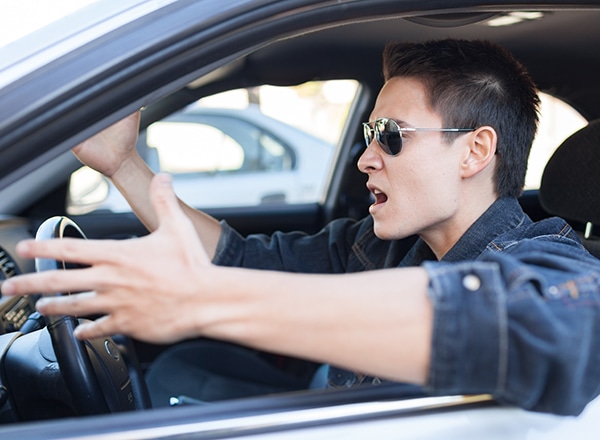How to stay safe in a road rage incident

Road rage is a driver’s aggressive or angry behaviour. Road rage may include rude gestures, verbal insults, physical threats or dangerous driving that is directed towards another driver. Sometimes road rage can result in physical harm to a driver or even death.
According to a 2015 online survey* a third of Canadians are victims of road rage at least once a month. Victims of road rage feel helpless, terrified – or angry, which can make a bad situation even worse.
While it can be hard to do, it’s important to stay calm and control your own anger when confronted with an aggressive driver. Following these tips can help keep you and your passengers safe.
- Lock your doors. If you sense that another driver is threatening you, make sure that all your car doors are locked.
- Do not react to aggressive drivers. If a driver cuts you off, tailgates, or drives aggressively, you may be inclined to honk your horn, gesture to the driver or otherwise engage with him/her. It is best to ignore the situation entirely.
- Avoid escalation. If the other driver yells at you, or gestures rudely out the window, don't shout or gesture back. An angry person can’t be in an altercation if another isn’t willing to join in. Keep your cool and carry on.
- Get out of the way. Put your turn signal on, and move over as soon as it is safe to do so to allow the other vehicle to pass. Put as much distance as possible between your vehicle and the angry driver’s vehicle.
- Find a safe place to stop. Don’t pull over the side of the road. The other car may follow you, and you could get into an altercation. Instead, drive to a safe place such as a police station, convenience store, shopping centre or even a hospital. If the angry driver follows, use your horn to attract attention. This will usually discourage an aggressor. Do not get out of your car.
- Do not go home – You may be followed. Continue to drive until you lose the other car, or can pull into a safe place where there are other people.
- Avoid eye contact. For drivers who express anger and frustration through their driving, eye contact can further upset them. Keep your eyes on the road, and try not to make eye contact with the enraged driver.
- When stuck in traffic, leave lots of room between your vehicle and the one ahead. Traffic jams can make even the most patient drivers frustrated. If you’re stuck in traffic, you may be inclined to creep up close to the vehicle in front of you. Instead, leave lots of room. If an aggressive driver confronts you, you want to be able to change lanes and get out of the way.
- Remember that it's not personal. Even though it may feel very personal, the angry driver doesn’t know you at all. He or she is angry at the situation and looking for an outlet for their rage.
- Grab vehicle information. If you are able, get the driver’s license plate number, make, and model of the vehicle in case the situation escalates and there is damage to your vehicle.
- Use your cell phone if absolutely necessary. Your mobile phone can be your best friend if your safety is threatened. If you're being followed or you feel an encounter is unavoidable, call 911 for help. They will send a police car to help, or advise you on what to do.
- Don’t offend other drivers. Often you don’t realize it, but you may have engaged in driving behaviour that sends a driver over the edge. Common road rage triggers are tailgating, using a cell phone while driving, being cut off, taking up two parking spots, and driving with pets on a lap.
If you’re a passenger in the car with an enraged driver
If you’re in a car with an angry driver, you can feel like a hostage. You need to do your best to calm the driver down for the safety of everyone. Admit to the driver that you are scared. Try to change the driver’s focus. Talk about your destination. Find a new radio station.
Unfortunately road rage is becoming a serious threat to Canadian drivers. You can do your part by exercising common sense and patience when you’re driving. The most important thing is that you and your passengers arrive safely.
*State Farm Canada Online Survey of 1,300 Canadian respondents of driving age, February 2015



.jpg?300x300)